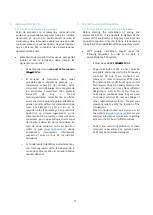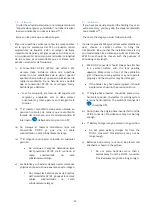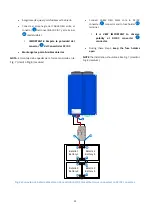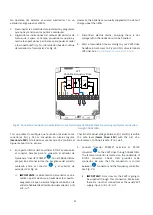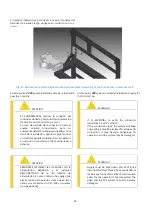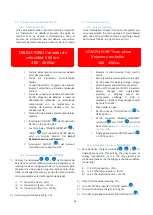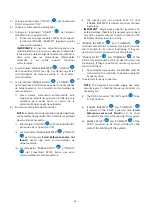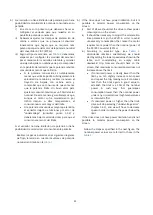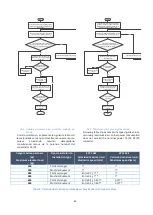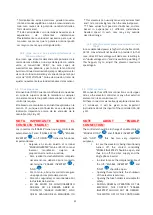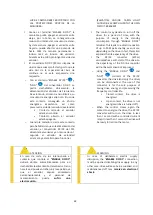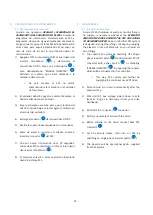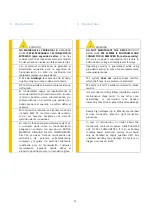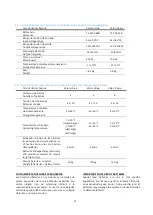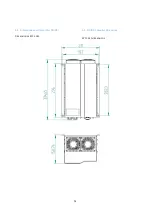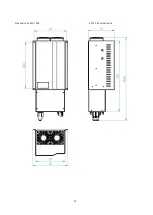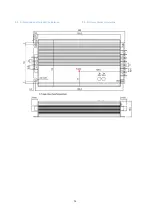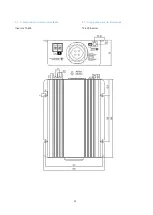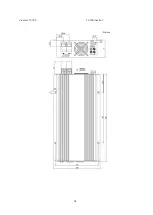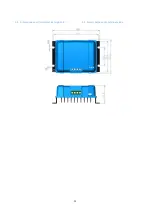
45
b)
Si el variador no tiene limitación de potencia, pero tiene
posibilidad de monitorizar la potencia consumida en su
pantalla
i)
En este caso lo primero que debemos hacer es
configurar el variador para que muestre en su
pantalla la potencia consumida.
ii)
Deberemos ajustar los tiempos de aceleración de
cabina a valores que no provoquen consumos
innecesarios que hagan que se requiera más
potencia por parte del motor de la potencia nominal
del convertidor DC/DC (EPCLL)
iii)
Según el tipo de ascensor, ver
Tabla 2
, deberemos
empezar por configurar la velocidad del ascensor
por el menor valor mostrado en la tabla, y ordenar
un viaje de bajada con cabina vacía para comprobar
en la pantalla del variador que la potencia máxima
consumida es menor que la límite.
•
Si la potencia consumida es notablemente
menor que el límite podrá subir ligeramente la
velocidad de la cabina y realizar de nuevo el
trayecto de bajada con cabina vacía y
comprobar que se consume de nuevo menos
que la potencia límite. Un buen valor para
ajustar el consumo máximo es un 90% del valor
nominal. De esta manera garantizaremos que,
aunque el motor sufra calentamiento por
tráfico intenso o altas temperaturas, el
consumo nunca será mayor del límite.
•
Si la potencia consumida es mayor que la límite,
el variador dejará de funcionar por error de
“undervoltage” (consultar punto
3.5.2) y
deberemos bajar la velocidad más para que el
consumo sea menor del límite.
Si el variador no tiene limitación de potencia ni tiene
posibilidad de monitorizar el consumo en la pantalla
Realizar los pasos indicados en el siguiente diagrama
de flujo, teniendo en cuenta los valores de potencia
nominal mostrados en la
tabla 1
:
b)
If the drive does not have power limitation, but it is
possible to monitor power consumption on the
screen.
i)
First of all, we should set the drive to show power
consumption on the screen.
ii)
It should be necessary to adjust the acceleration
time parameters (in the VVVF) in order to avoid
unnecessary consumption that make the motor
requires more power than the nominal power of
the DC/DC Converter (EPCLL)
iii)
According to elevator type, (see
Velocidades máximas orientativas) we should
start by setting the lower speed value shown in the
table, and commanding an empty cabin
downward trip. Now we should check on the
screen, that maximum consumed power does not
increase above the limit.
•
If consumed power is clearly lower than the
limit, you can slightly increase cabin speed
and repeat the trip, making sure it consumes
less than the limit again. A good value to
establish the limit is a 90% of the nominal
power in such way that guarantees
consumption lower than the nominal power
under any circumstances (high temperatures
or intense traffic).
•
If consumed power is higher than the limit,
drive will stop working (“undervoltage error”,
chapter 3.5.2), and we will have to decrease
speed in order to reduce the power below the
limit.
If the drive does not have power limitation and is not
possible to monitor power consumption on the
screen.
Follow the steps as specified in the next figure. The
nominal power values are referred to those in the
table 1
:
Содержание P2S Series
Страница 1: ...1 Manual de instalaci n Installation guide P2S Series plug single phase P2S powered by...
Страница 2: ...2 Versi n 4 6 June 2018 Epic Power Converters S L...
Страница 9: ...9 Fig 3 Convertidor DC DC 5k5 5k5 DC DC Converter 0 1 2 3 4 6 10 9 7 8 5...
Страница 55: ...55 Dimensiones EPCL 5K5 EPCL 5k5 dimensions...
Страница 56: ...56 6 6 Dimensiones del cargador de bater as 6 6 Battery charger dimensions...
Страница 57: ...57 6 7 Dimensiones del inversor monof sico 6 7 Single phase inverter dimensions Inversor TS 400 TS 400 Inverter...
Страница 58: ...58 Inversor TS 700 TS 700 Inverter...
Страница 59: ...59 6 8 Dimensiones del Controlador de carga solar 6 8 Solar charge controller dimensions...
Страница 61: ...61 6 9 2 Bastidor bater as Small 4x1 6 9 2 Small batteries rack 4x1...
Страница 62: ...62 6 9 3 Bastidor bater as Medium 6 9 3 Medium batteries rack...

